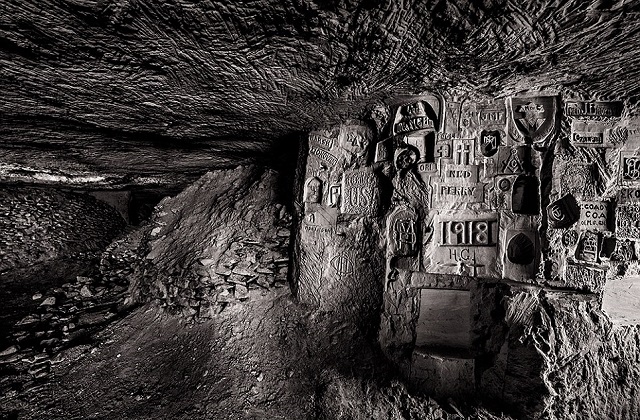Relatively speaking, not many WWI tunnels have been photographed. Although it is commonly known that soldiers often sought safety underground in the midst of shelling and gunfire, most would have assumed that there was not much to see aside from dark, hollowed soil. It turns out that this assumption would have been completely wrong, as photographers recently burrowed their way into a number of WWI tunnels and discovered a great deal of unknown history in the process.
The pictures, taken by Texas native Jeff Gusky, show the interiors of hideouts used in France. Gusky and his colleague, Evan Hadingham, discovered a number of engravings in many of the hideouts. The help to show the immense amount of time which occasionally passed while the soldiers were busy hiding in the WWI tunnels, Gusky and Hadingham actually took a count of the engravings they found. This count totaled approximately five hundred, which they determined were carved over a period of just about a month and a half. Most of the carvings were found at Chemin des Dames, and bore personal invitations on the soldiers who carved them.
Some of the underground quarries that Gusky and Hadingham explored even had furniture in them, along with remnants of meals and liquor shared by the soldiers who took refuge together in the WWI tunnels.They found that some of these dugouts were so carefully maintained that they were even able to house utilities such as electricity. This allowed the men to spend more time in their underground hovels as they waited for conditions overhead to clear, the Mail Online reports.
These underground quarries were not completely safe. Enemies were usually aware of them, and therefore could have been prone to dig their way through the walls at any point. Even when they were mostly safe in the WWI tunnels, men still had to stay on their guard. Smarter enemies would not dig all the way through, but would rather dig close enough to plant bombs or other ordnance. Eventually, these hideouts were abandoned entirely.
The WWI tunnels became unnecessary around the time the war ended. Soldiers were no longer limited almost exclusively to trench warfare due to the rise of vehicular support. Once soldiers were able to fight on the go, the use of underground WWI tunnels simply did not make as much sense. When they left, however, they did not fill in the holes they left. This allowed men such as Gusky and Hadingham to explore their stories later.
